Home Decor
Can I Bring Home Decor on a Plane
Yearning to bring home decor on a plane? Discover essential tips and guidelines for safely transporting your favorite items.
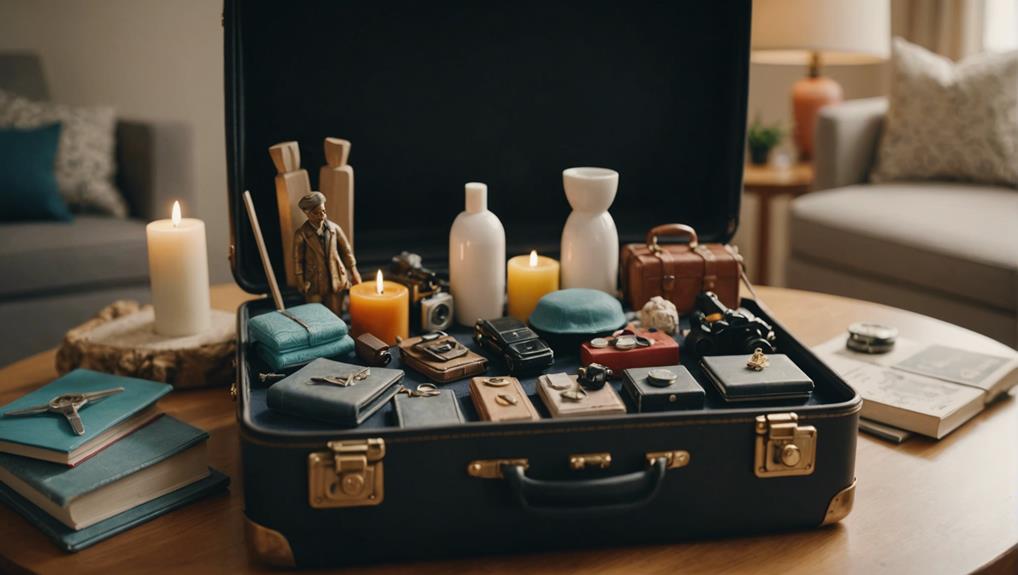
You can bring home decor on a plane, including vases, mirrors, picture frames, and sculptures. TSA allows delicate glass decor when packed securely. Use plastic containers and tissue paper for protection – place fragile items in the middle of your luggage for cushioning. For oversized items, consider shipping or special arrangements. Follow TSA guidelines for a smooth journey. Additional details on handling plants, electronics, and prohibited items are available. Guarantee your decor arrives safely by preparing and packing thoughtfully. Learn more about specific guidelines for different types of home decor during air travel.
Key Takeaways
- Use plastic storage containers for fragile home decor items.
- Wrap delicate decorations in tissue paper for cushioning.
- Secure items between clothes in luggage to prevent damage.
- Follow TSA guidelines for transporting fragile decor safely.
- Position fragile items in the middle of luggage for protection.
Allowed Home Decor Items
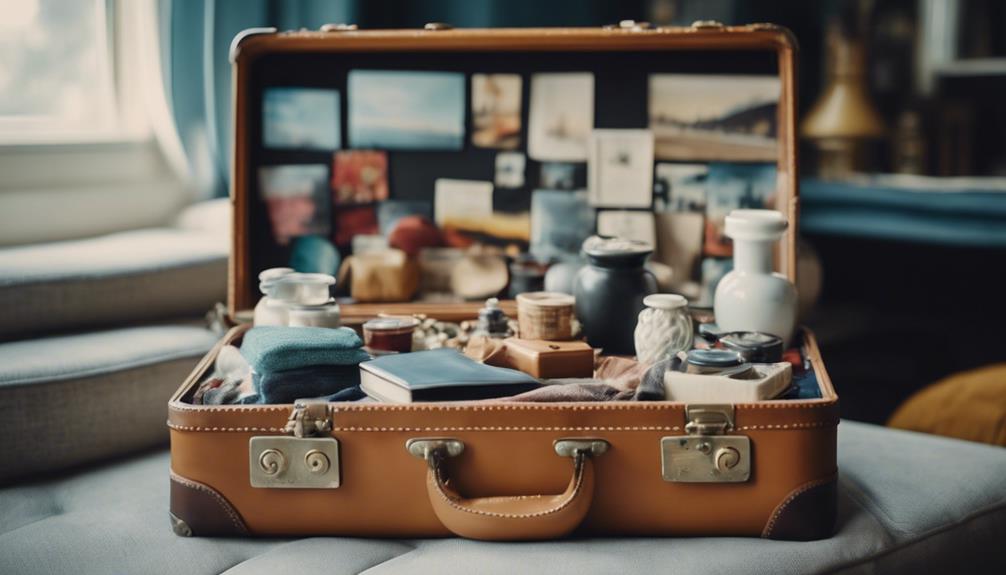
When traveling by plane, you can bring vases, mirrors, picture frames, sculptures, and candle holders as part of your home decor items. These delicate glass home decor pieces are typically allowed by TSA regulations in both carry-on and checked bags.
To guarantee the safety of these items during travel, it's crucial to pack them properly. Consider using packing techniques such as placing fragile items in the middle of your suitcase surrounded by soft clothes for cushioning. Additionally, wrapping delicate items in tissue paper or securing them in plastic storage containers can provide added protection against potential damage.
Packing Tips for Home Decor
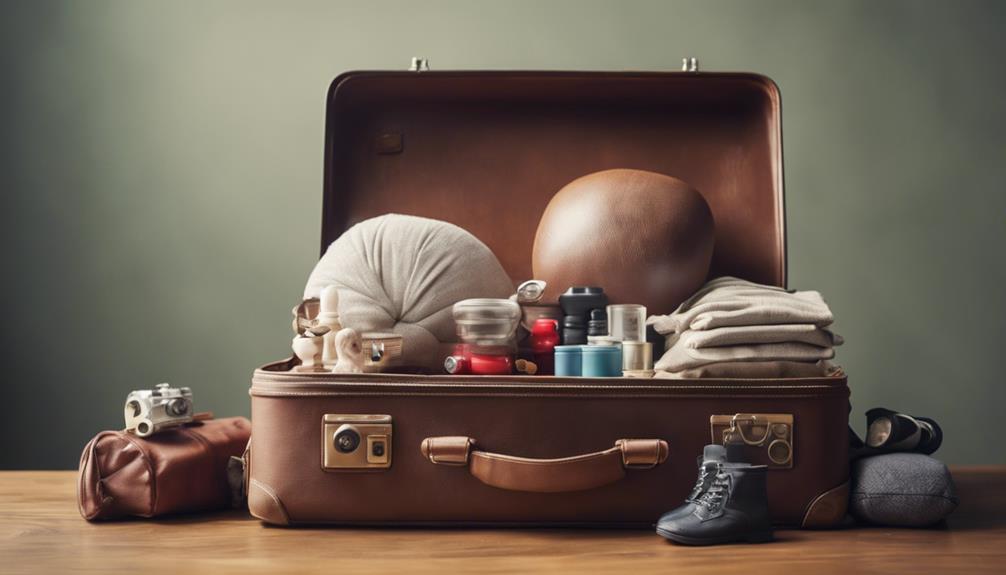
When packing home decor items for a flight, remember to use plastic storage containers for delicate decorations, keeping them safe during travel.
Secure fragile items snugly between clothes in your checked luggage to prevent any damage in transit.
It's also helpful to wrap delicate items in puffy tissue paper for added protection.
Item Size Restrictions
For safely packing delicate home decor items like vases, mirrors, picture frames, sculptures, and candle holders, it's imperative to take into account item size restrictions and proper protection methods during travel.
These fragile decorations can be placed in both carry-on and checked bags. Utilize plastic storage containers or wrap items in puffy tissue paper for protection during travel.
To prevent shifting, consider snugly placing delicate items between clothes in your luggage. When transporting fragile items, position them in the middle of the suitcase surrounded by soft clothes to minimize the risk of damage.
For added security, Disney offers shipping services for breakable items, ensuring a safe arrival and easy replacement if items arrive broken.
Secure Packaging Methods
To safeguard delicate home decor items during travel, employ secure packaging methods such as using plastic storage containers and wrapping items in puffy tissue paper. When packing for your trip, make sure to keep fragile items wrapped and protected. Utilize the original packaging if possible, as it offers an additional layer of safeguarding.
For checked luggage, pack your home decor snugly between clothes to prevent any shifting that could lead to damage. Position delicate items in the middle of your suitcase to minimize the risk of breakage. By wrapping your fragile home decor in puffy tissue paper, you provide extra cushioning to guarantee they arrive at your destination unharmed.
Fragile Items Handling
As you handle fragile items when packing your home decor, remember to utilize plastic storage containers for added protection during travel. To safeguard delicate items, cushion them with puffy tissue paper and secure them snugly between clothes in checked luggage.
When packing, keep Disney packaging on items for extra safeguarding. Place fragile decorations in the middle of the suitcase to prevent shifting during the journey.
These packing tips guarantee your delicate home decor arrives safely at your destination. By following these travel tips, you can protect your fragile items and enjoy your beautifully decorated space wherever you go.
Restrictions on Fragile Items
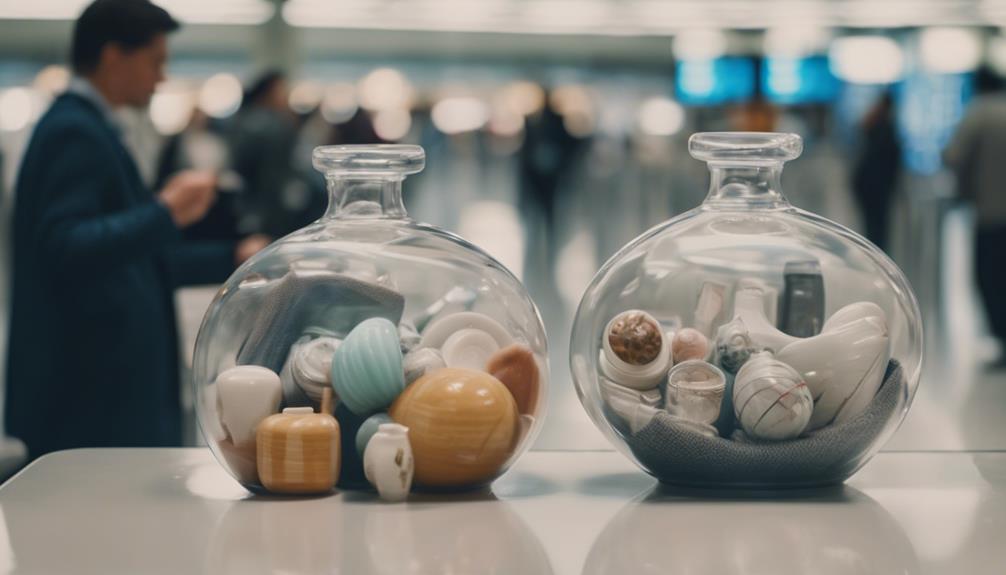
Traversing the skies with delicate decorations demands meticulous attention to airline regulations to guarantee safe travel for your fragile items. Fragile items like vases, mirrors, picture frames, sculptures, and candle holders are generally permitted on planes.
To guarantee their safety, pack delicate decorations snugly in plastic storage containers. When placing them in your luggage, cushion fragile items with soft clothes and position them in the middle of the suitcase to prevent damage during the flight.
If you're concerned about transporting breakable items, consider utilizing shipping services offered by airlines to make sure they arrive home intact. By following these guidelines and taking extra care when handling fragile items, you can bring your home decor on a plane without worrying about damage during your journey.
Special Considerations for Artwork
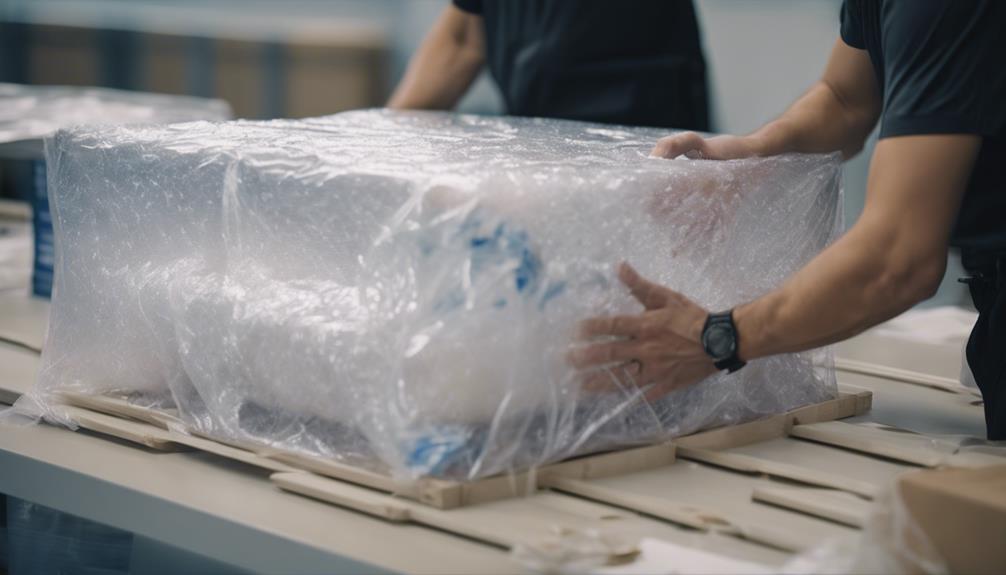
When transporting delicate artwork on a plane, make certain it's securely packed to prevent any damage during your journey. Consider using plastic storage containers or wrapping the artwork in puffy tissue paper for added protection. Place fragile items in the middle of your suitcase surrounded by soft clothes to minimize the risk of breakage.
To guarantee the safe arrival of delicate decorations, you can also utilize shipping services provided by companies like Disney for a stress-free transport process. Remember to well-pad and secure delicate decor items in your luggage to prevent shifting during the flight. Taking these precautions will help safeguard your artwork and fragile items from potential damage while traveling.
Dealing With Oversized Decor Pieces

If you find yourself struggling to fit oversized decor pieces into your luggage, consider disassembling them for easier transport. Fragile items, in particular, require special attention to prevent damage. Before attempting to bring large decor items on a plane, make sure you are aware of airline guidelines regarding checked luggage and oversized items. It's crucial to pack these items securely to avoid any mishaps during the journey. If your decor pieces are exceptionally large or delicate, utilizing shipping services may be the most reliable option to guarantee their safe arrival. Here is a table summarizing key points for dealing with oversized decor pieces:
| Key Points |
|---|
| Disassemble large decor items |
| Pack fragile items carefully |
| Check airline guidelines |
| Utilize shipping services |
| Proper packing instructions |
Tips for Bringing Plants

Consider securing your plants properly to guarantee a smooth journey when bringing them on a plane. Before deciding to bring plants as carry-on items, make sure they can fit in the overhead compartment or under the seat. Different airlines may have specific regulations regarding the transportation of plants, so it's important to check their requirements beforehand.
To ensure security during the flight, ensure your plants are adequately secured to prevent any tipping over. Checking the size of your plant and the available cabin space is essential to avoid any issues during transportation.
Guidelines for Electronic Decor
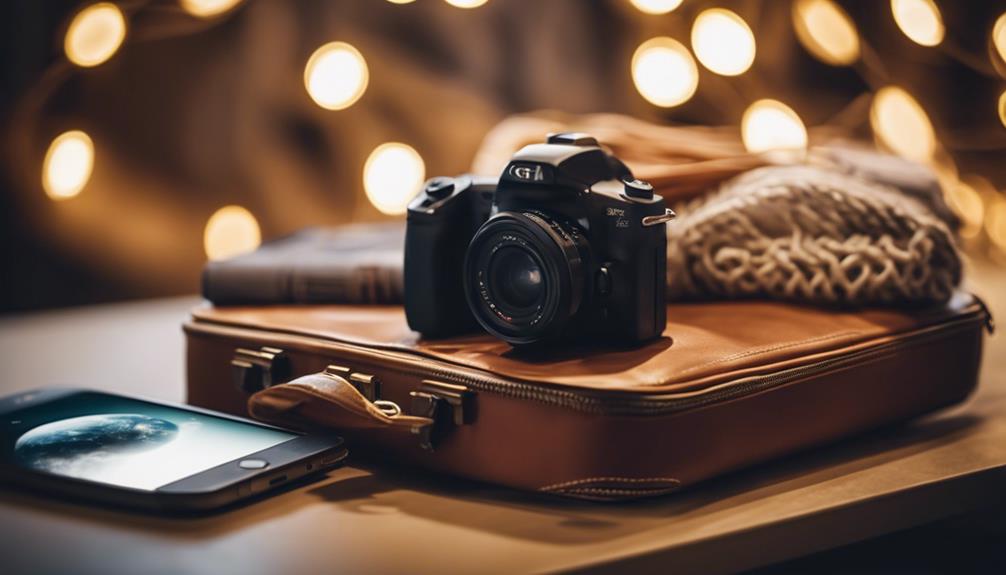
Wondering how to safely transport your electronic decor items on a plane? When it comes to items like colorful string lights, fragile glass decor, delicate ornaments, or even your beloved Disney decorations, there are some guidelines to follow. You can pack colorful string lights in both carry-on and checked bags without any issues. Fragile glass decor items such as vases, mirrors, and sculptures are also allowed in both carry-on and checked bags, but make sure to wrap delicate ornaments and picture frames in protective tissue paper. Disney-themed decorations can be stored in plastic containers within your luggage to prevent damage. If you have particularly fragile items, utilizing shipping services offered by Disney can guarantee a safe arrival at your destination without the risk of breakage.
| Type of Electronic Decor | Allowed in Carry-On Bags | Allowed in Checked Bags |
|---|---|---|
| String Lights | Yes | Yes |
| Fragile Glass Decor | Yes | Yes |
| Delicate Ornaments | Yes | Yes |
Prohibited Items in Home Decor
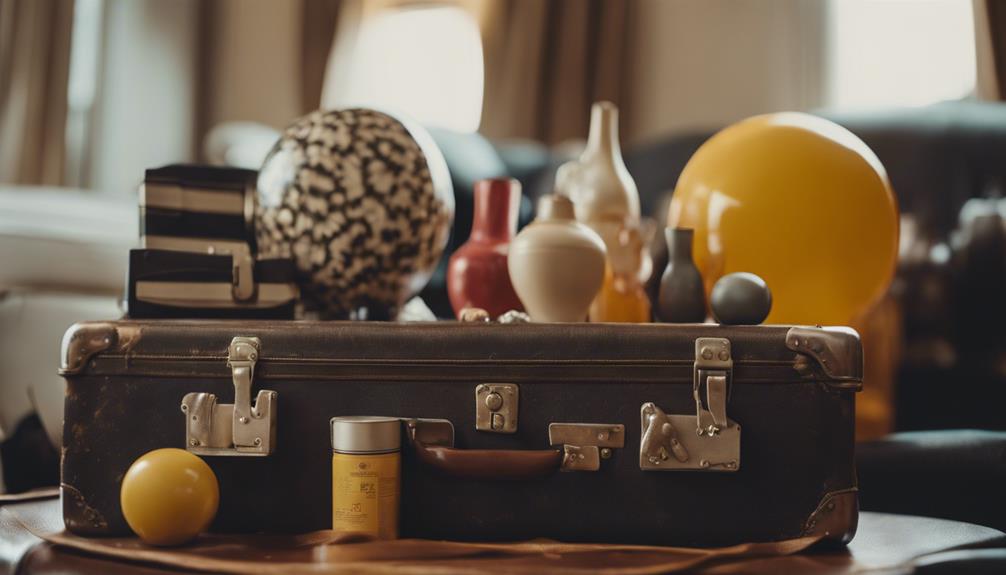
To guarantee a smooth journey with your home decor items, be aware of the prohibited items that you shouldn't pack when traveling by plane. When it comes to delicate home decor, it's important to avoid including sharp or prohibited items that could cause issues at the security checkpoint.
While glass items like vases, mirrors, picture frames, sculptures, and candle holders are generally allowed in both carry-on and checked bags, it's vital to securely pack fragile items to prevent damage during travel. Consider using plastic storage containers or padding with clothes to protect these delicate pieces.
Before packing, make sure to check TSA guidelines for any specific restrictions on certain types of home decor items. By being mindful of prohibited items and taking precautions to safeguard delicate home decor, you can ensure a hassle-free and safe journey for both you and your cherished items.
Additional Resources and Tips
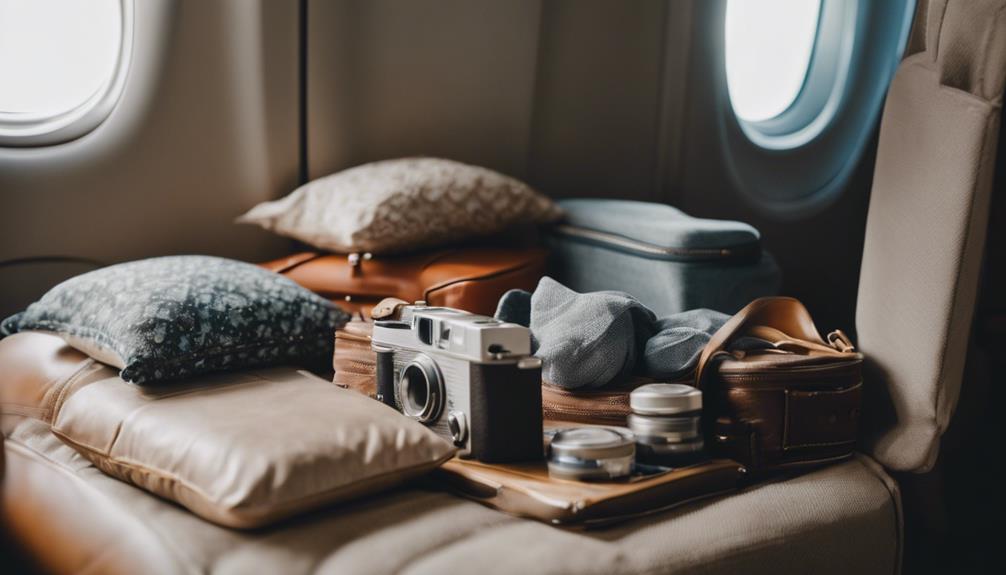
When it comes to bringing home decor on a plane, packing fragile items securely is important.
You should also be aware of security regulations regarding decor items and consider size limitations for your carry-on or checked bags.
These points will help guarantee a smooth and stress-free travel experience with your delicate decorations.
Packing Fragile Items
For added protection when packing fragile items for travel, consider using plastic storage containers to safeguard delicate decorations. These containers provide a sturdy barrier against breakage and can help keep your items secure during the journey.
When packing delicate decorations, make sure to pack them snugly between clothes in your suitcase to prevent any shifting that could cause damage. Additionally, placing delicate items in the middle of your luggage can minimize movement and reduce the risk of breakage.
To provide extra cushioning and protection, wrap fragile items in puffy tissue paper before placing them in containers or suitcases. Taking these precautions can help guarantee your fragile decor arrives safely at its destination.
Security Regulations for Decor
Consider utilizing storage containers to comply with security regulations and safeguard your delicate home decor items during travel. When transporting fragile items, it's important to adhere to TSA guidelines and pack securely to prevent damage.
Here are some protective measures to help you navigate security regulations for your decor:
- Use plastic storage containers for easy transportation.
- Wrap delicate items in puffy tissue paper to provide cushioning.
- Place soft clothing around fragile decorations for added protection.
- Follow TSA guidelines to guarantee compliance and smooth transit of your decor.
Size Limitations for Items
To guarantee your delicate home decor items comply with TSA guidelines and size limitations for air travel, it's vital to carefully consider the dimensions of each item before packing.
When transporting fragile items in your checked baggage, use plastic storage containers or wrap them in cushioning materials like puffy tissue paper. Make sure that delicate decorations are secured snugly between clothes to prevent shifting and potential damage.
Items with breakable components or fluids should be stored in containers to prevent leaks or breakage during the flight. For added protection, place fragile items such as ornaments or snowglobes in the middle of your suitcase, surrounded by soft clothes or additional cushioning materials to minimize the risk of damage while in transit.
Frequently Asked Questions
Can You Bring Decorations on a Plane?
Yes, you can bring decorations on a plane. Delicate items like vases or picture frames are allowed. It's best to pack them carefully in plastic containers or wrap them in tissue paper. Placing them snugly among your clothes can prevent damage during travel.
Disney even offers shipping for breakable items. For smaller decorations, consider using plastic containers and shipping services for stress-free transport of delicate items.
What Makeup Items Are Not Allowed in Carry-On?
In carry-on bags, certain makeup items are restricted. Liquid makeup products like foundations, primers, and liquid lipsticks must be in containers of 3.4 ounces or less. Cream and gel items such as mascaras and eyeliners follow the 3-1-1 liquids rule.
However, powders like eyeshadows and blushes usually have no specific size restrictions. Tools, brushes, and non-liquid makeup can typically be packed without extra limitations.
Remember to use a clear, resealable plastic bag for smooth security checks.
What Thing Can You Not Bring on a Plane?
You can't bring explosives, flammable items, or sharp objects such as knives on a plane.
It's crucial to adhere to TSA guidelines to guarantee a safe and smooth travel experience.
Remember to check the restricted items list before packing your bags.
Stay informed and pack responsibly to avoid any issues at airport security checkpoints.
Your cooperation helps maintain safety for all passengers during air travel.
Can You Bring Homemade Goods on a Plane?
Yes, you can bring homemade goods on a plane. However, certain restrictions apply, like the limit on liquids and gels in carry-on bags.
Homemade food items may also be subject to additional screening. Make sure to check the TSA guidelines for specifics on what's allowed.
Packing these goods securely and clearly labeling them can help speed up the security process and guarantee they arrive safely at your destination.
Conclusion
To summarize, bringing home decor on a plane is allowed, but there are some restrictions and considerations to keep in mind. From packing tips to guidelines for electronic decor, it's crucial to plan ahead and make certain your items are safe and secure during travel.
So, next time you're thinking about bringing home decor on a plane, remember to follow these tips for a smooth and hassle-free journey. Can your decor make it through security and arrive intact at your destination?
Home Decor
Blending Modern and Traditional Decor – The Results Will Blow You Away!
Get ready to discover how blending modern and traditional decor can create an unforgettable aesthetic that will leave you in awe!
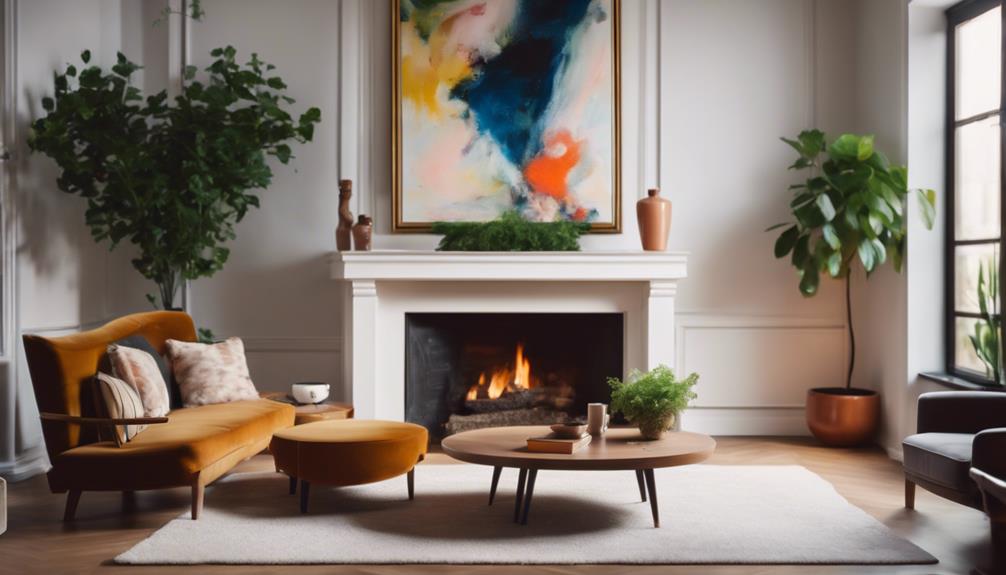
Blending modern and traditional decor can completely transform your space into a stunning visual feast. You can achieve a balanced look by pairing sleek, contemporary furniture with intricate, vintage pieces. Focus on complementary colors and textures to create harmony. Use statement accessories and unique artwork to personalize your space. Mixing materials, like pairing warm woods with cool metals, adds depth. Remember to reflect on architectural features to enhance the overall aesthetic. The results will indeed blow you away! If you're curious about how to elevate your style further, there's plenty more to explore.
Key Takeaways
- Combine sleek modern furniture with intricate traditional pieces for a dynamic visual contrast in your decor.
- Use a cohesive color palette to ensure modern and traditional elements complement each other effectively.
- Incorporate diverse textures, such as smooth finishes and rich fabrics, to enhance depth and interest in your space.
- Select statement accessories and curated collections to refresh traditional areas without overwhelming the overall aesthetic.
Understanding Furniture Styles
Understanding furniture styles is essential for creating a harmonious blend of modern and traditional decor in your space.
You'll find that modern furniture, designed from the mid-20th century onward, emphasizes sleek lines and minimalism. In contrast, traditional furniture, such as Chippendale, Victorian, or Gustavian pieces, showcases intricate details and craftsmanship. By grasping these distinctions, you can make informed choices that enhance your home's aesthetic.
To achieve a balanced look, it's vital to thoughtfully integrate traditional elements with modern pieces. For instance, placing a contemporary coffee table alongside a classic sofa can create a striking visual contrast. You can also consider transitional furniture, which often aligns with modern design principles but incorporates some traditional flair. This approach can serve as a bridge between the two styles, making it easier to blend them seamlessly.
Ultimately, you'll want to focus on selecting pieces that complement one another while maintaining a cohesive color palette. This way, your space feels intentional and inviting, drawing attention to both the modern and traditional elements that define your unique style.
Techniques for Effective Mixing
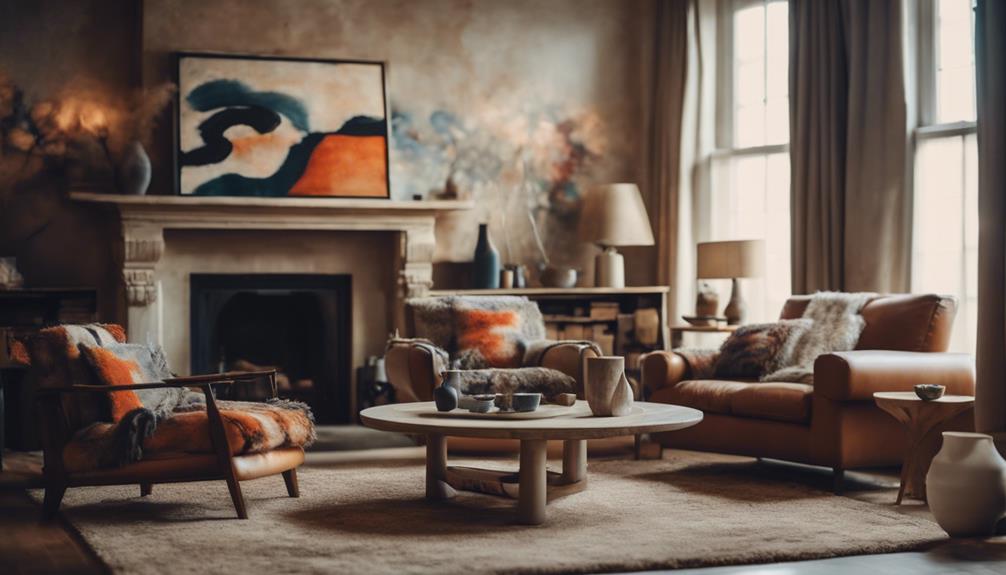
When mixing modern and traditional decor, focus on complementary furniture pairing to create a cohesive look.
You'll want to pay attention to color and texture harmony, ensuring elements enhance each other rather than clash.
Complementary Furniture Pairing
Pairing modern and traditional furniture can transform your space into a harmonious blend of styles that enhances visual appeal. To achieve effective complementary furniture pairing, start by selecting pieces that create striking contrasts. For instance, place a modern side table next to a traditional sofa; this combination maintains a cohesive look while highlighting both styles.
Consider using traditional dining chairs with a modern dining table to establish a balanced aesthetic. Look for furniture featuring slight stylistic differences, like a vintage armchair upholstered in contemporary fabric, to add visual interest without overwhelming your space. Additionally, incorporating contrasting materials can provide depth; think of a sleek glass coffee table paired with a rustic wooden cabinet.
While mixing styles, be mindful not to introduce excessive variety. Aim for a curated selection that celebrates the harmony between modern and traditional elements. This approach prevents chaos and allows for a more sophisticated blend in your decor.
Color and Texture Harmony
Achieving color and texture harmony between modern and traditional decor requires a careful selection of complementary shades and finishes that unify the space.
To create a cohesive look, consider these techniques:
- Choose a cohesive color palette: Select a mix of complementary shades that resonate with both styles, ensuring they blend seamlessly.
- Incorporate textural variety: Pair smooth modern finishes, like glass or metal, with the rich textures of traditional fabrics, such as velvet or brocade, to add depth and interest.
- Use a patterned rug: A single patterned rug can serve as a focal point, anchoring the room while harmonizing the color and textures of both modern and traditional elements.
- Add contemporary accents: Utilize accessories, like modern vases or artwork, to introduce fresh color accents that enhance traditional furniture without overwhelming the overall aesthetic.
Balance Through Contrasting Materials
Blending modern and traditional decor effectively involves balancing contrasting materials to create visual interest and highlight the unique characteristics of each style. You can achieve this by mixing contrasting materials, like pairing sleek metal with warm wood. This combination not only adds depth but also showcases the beauty of both modern and traditional furnishings.
Incorporate modern elements such as glass or lucite alongside traditional fabrics to enhance the dynamic interplay of old and new. For instance, using a soft velvet on a traditional chair paired with a contemporary leather sofa maintains balance while enhancing comfort and aesthetic appeal.
Don't forget about statement accessories; a bold, geometric metal sculpture set against an ornate wooden sideboard can refresh a traditional space without overwhelming it. When selecting these materials, focus on achieving harmony through color and form, ensuring that neither style overpowers the other.
Elements for Successful Blending
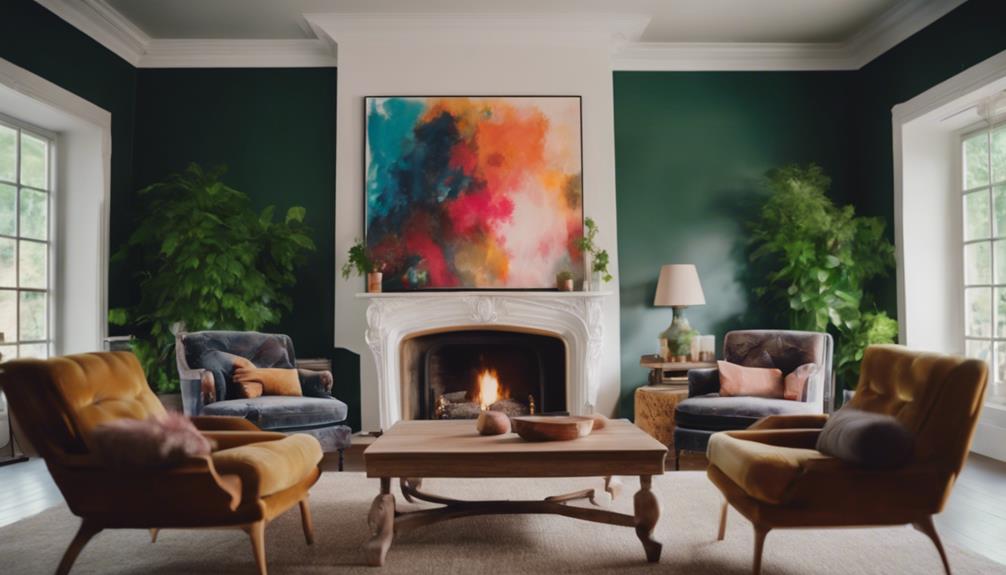
Successful integration of modern and traditional decor hinges on the thoughtful selection of complementary elements that create visual harmony. To achieve this balance in your interior design, consider these essential elements:
- Furniture Pairing: Combine modern side tables with traditional sofas. This mix guarantees that each piece enhances the other's character without clashing.
- Accent Pieces: Incorporate contemporary lighting fixtures and abstract art in your traditional settings. These modern accents can uplift the overall aesthetic without overwhelming the space.
- Color Schemes: Utilize cohesive color palettes that blend modern hues with traditional tones. This approach helps shift the room's vibe toward modernity while respecting its classic roots.
- Textures and Materials: Mix materials like pairing a sleek, modern coffee table with a vintage hutch. This not only introduces visual interest but also keeps the design from feeling chaotic.
Architectural Influences on Design
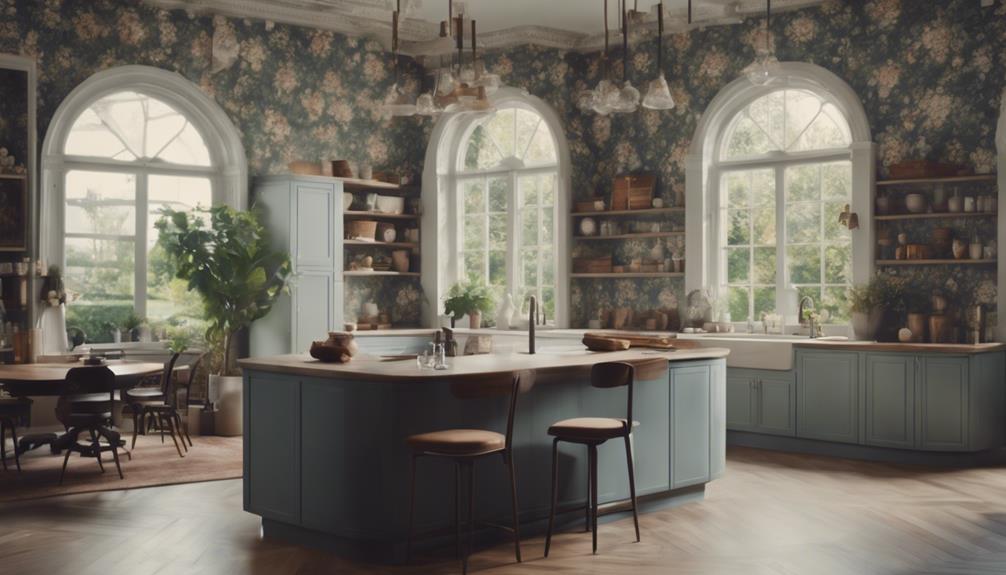
The architectural features of your space, like high ceilings and ornate moldings, set the stage for seamlessly integrating modern and traditional design elements. When you acknowledge these characteristics, you can enhance the charm of your home while incorporating contemporary flair.
Consider using historical details, like stained glass windows or chippy paint, to create a unique backdrop that highlights both styles. This balance respects the original design while allowing for eclectic modern accents.
Here's a simple table to visualize how architectural features can influence your choice of furniture:
| Architectural Feature | Suggested Piece of Furniture |
|---|---|
| High Ceilings | Tall, slim bookcases |
| Ornate Moldings | Classic wooden dining table |
| Stained Glass Windows | Minimalist modern chairs |
| Chippy Paint | Vintage side tables with a twist |
Shopping for Unique Pieces
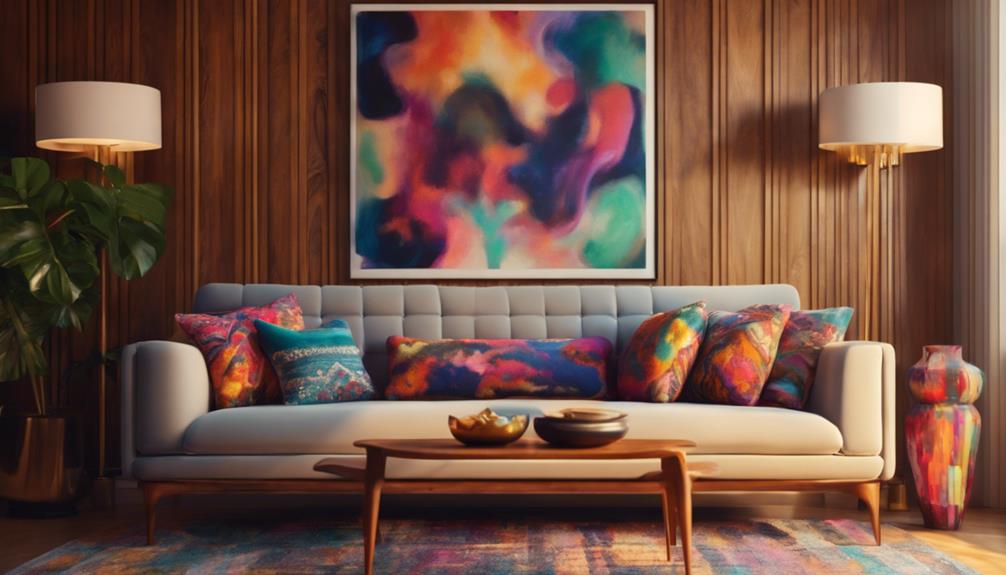
Finding unique pieces that effortlessly combine modern and traditional styles can elevate your home's decor to new heights. When shopping for unique pieces, here are some strategies to contemplate:
- Explore curated collections: Retailers like Anthropologie and West Elm offer selections that blend both aesthetics beautifully, making it easier to find standout items.
- Utilize online platforms: Browse various websites for a wide range of furniture options, from neutral tones to vibrant colors, enhancing your space's overall look.
- Seek out classic designs: Look for vintage furniture or traditional accessories that can complement modern pieces, creating a balanced mix.
- Engage with design communities: Follow popular design blogs or social media channels for inspiration and insights on how to find unique pieces that resonate with your personal style.
Working with an interior designer can also help you identify unique finds that marry modern and traditional elements effortlessly.
By following these tips, you'll be well on your way to creating a unique and cohesive decor that truly reflects your aesthetic.
Happy hunting!
Personalizing Your Space
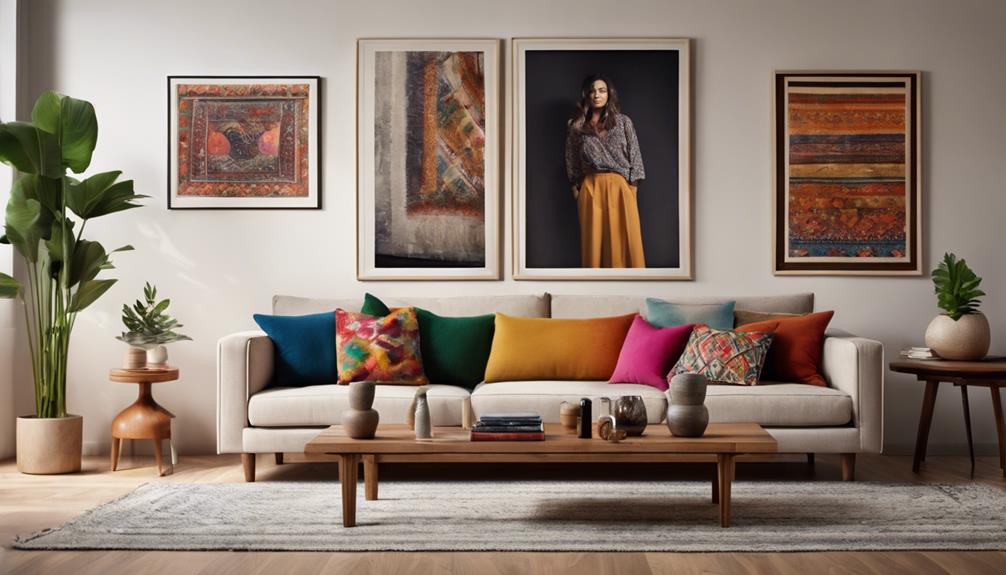
Personalizing your space starts with incorporating unique touches that reflect your individual style.
Whether it's a vintage piece that sparks joy or a modern accessory that adds a pop of color, each item should tell your story.
Unique Personal Touches
Incorporating unique personal touches into your decor not only enhances the aesthetic but also transforms your space into a true reflection of who you are. By blending modern and traditional elements, you can create a home that tells your story.
Here are some ideas to help you personalize your decor:
- Unique Artwork: Choose pieces that resonate with you, like abstract works or traditional portraits, to showcase your experiences and tastes.
- Personal Mementos: Display curated collections or travel souvenirs that highlight your journey and add character to your space.
- Customized Textiles: Incorporate reupholstered chairs or handmade cushions that bridge modern and traditional styles, offering both comfort and a personal touch.
- Vintage Finds: Incorporate family heirlooms or thrifted treasures. These elements not only add soul and character but also serve as great conversation starters.
Reflecting Individual Style
How can you blend modern and traditional elements to create a space that truly reflects your individual style? Start by incorporating vintage items alongside contemporary accessories. This mix not only adds character but also reflects your personality and history, creating a curated look that feels authentic.
Think about using a cohesive color palette, like soothing gray tones, to unify diverse styles and make your space feel harmonious.
Select statement pieces that speak to your taste, such as a modern cerused wood table paired with a traditional hutch. These focal points can express who you're while maintaining balance in the room.
Don't forget to emphasize comfort and livability in your design choices, as these elements are essential for a space that's both inviting and reflective of your lifestyle.
When personalizing your space, consider what truly resonates with you. Something that I've found helpful is to combine items that tell your story—whether it's a treasured heirloom or a sleek modern piece. This approach not only enhances the visual appeal but also guarantees your home is a true representation of you.
Frequently Asked Questions
Can You Mix Traditional and Modern Decor?
Yes, you can mix traditional and modern decor! By selecting complementary colors, textures, and functional furniture, you'll create a harmonious balance. Just guarantee each piece enhances the overall aesthetic without overwhelming the space.
Can You Mix Modern and Traditional Art?
Absolutely, you can mix modern and traditional art! Choose pieces that complement each other's colors, and balance them thoughtfully. This way, both styles will shine, enriching your space with dynamic visual contrast and depth.
Can You Mix Modern and Old Furniture?
You might think mixing modern and old furniture feels risky, but it actually creates a warm, inviting space. By pairing unique pieces, you'll discover a harmonious balance that reflects your personal style beautifully.
What Is the Difference Between Modern and Traditional Decor?
Modern decor features clean lines and minimalism, while traditional decor showcases ornate details and craftsmanship. Understanding these differences helps you create a cohesive space that reflects your style, combining elements effectively for a balanced look.
Conclusion
By blending bold modern pieces with timeless traditional touches, you can create an enchanting and cohesive space that truly reflects your personality.
Don't shy away from mixing materials and styles; instead, embrace the eclectic essence of your environment.
Remember, every unique element tells your story.
So, immerse yourself in the delightful design journey, and watch as your home transforms into a stunning sanctuary that showcases your distinctive style and flair.
Happy decorating!
Home Decor
Must-Have August Home Accessories for a Stylish Update – Don’t Miss These!
Must-have August home accessories await to transform your space—discover the stylish updates that could elevate your decor!
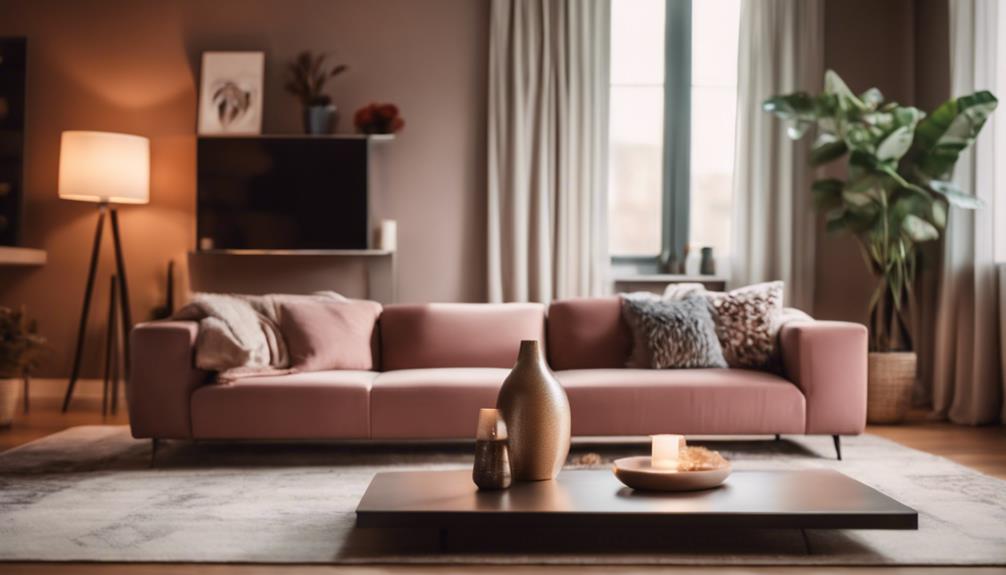
August is your chance to elevate your home decor with stylish accessories. Start with chic faux leather pillow covers for a trendy touch. Oversized artwork not only makes a statement but also sparks conversations. Don't overlook affordable hurricane vases; they brighten up your space with seasonal florals. Transform your lamp shades to enjoy a refreshed ambiance. For added sophistication, include coffee table books showcasing black and white photography. These must-haves will breathe new life into your home. Stick around, and you'll discover even more stylish updates that can complement your unique taste!
Key Takeaways
- Incorporate stylish faux leather pillow covers for texture and seasonal contrast in your home decor.
- Use oversized artwork as a striking focal point and conversation starter in any room.
- Add affordable hurricane vases to enhance floral arrangements and bring seasonal ambiance indoors.
- Transform existing lamp shades with darker tones to elevate the overall room ambiance.
Essential Textiles for August
August's essential textiles, like stylish faux leather pillow covers and oversized artwork, can instantly elevate your home decor for the season. These textiles not only enhance your space but also provide a chic upgrade that reflects your personal style. By incorporating unique decorative accents, you can create a warm and inviting environment that feels refreshed and seasonal.
When it comes to budget-friendly options, don't overlook affordable hurricane vases and florals, which can add a pop of color and life without breaking the bank. Transform existing textiles, such as lamp shades or table runners, to give your home a renewed look that's both practical and visually appealing.
Engaging in local shopping experiences is a great way to discover distinctive textiles that stand out from mass-produced items. You'll find unique pieces that not only elevate your home decor but also support your community.
Embrace these essential textiles this August as you make seasonal updates to your living space. With a little creativity and the right elements, your home can transform into a stylish oasis you'll love coming home to.
Unique Decorative Accents
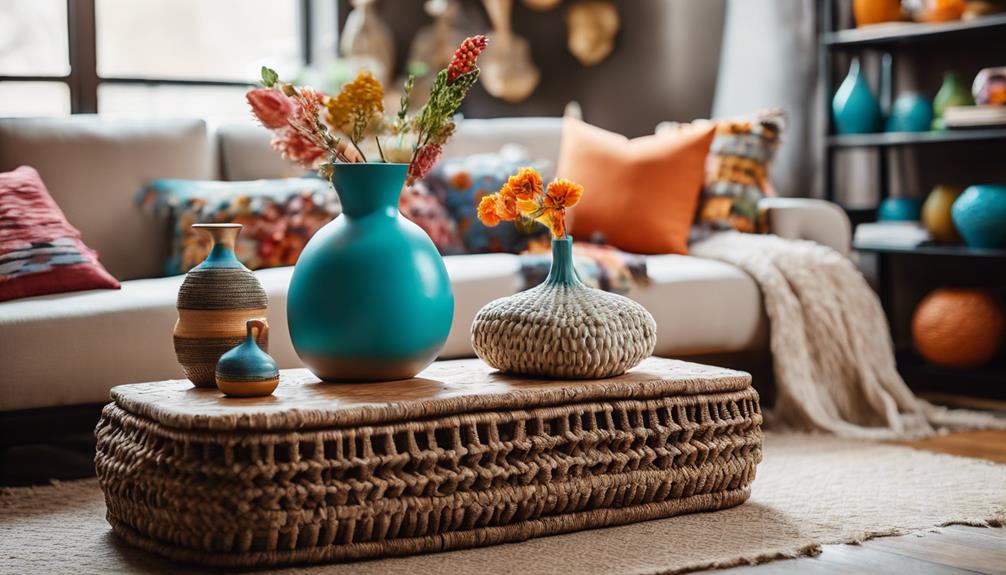
To truly elevate your home decor, incorporating unique decorative accents can make all the difference, turning ordinary spaces into personal showcases of style and creativity.
Start with oversized artwork that serves as a striking conversation starter, allowing you to express your individuality. Faux leather pillow covers add texture and contrast, making them perfect for seasonal updates, especially as you shift into fall.
Don't overlook the impact of decorative pieces like hurricane vases. They're not only budget-friendly but also enhance your floral arrangements, bringing seasonal ambiance to any room. You can fill them with seasonal blooms or even decorative stones for a chic look.
A stylish living space isn't complete without a well-placed coffee table book, particularly one featuring stunning black and white photography. This not only acts as an aesthetic element but also provides inspiration and a touch of sophistication.
Seasonal Color Trends

Embracing seasonal color trends can transform your home, making it feel fresh and inviting with each change of the year. By incorporating these colors into your home decor, you can align with current consumer preferences while achieving a stylish update.
| Season | Color Palette |
|---|---|
| Spring | Pastel colors |
| Summer | Vibrant hues |
| Fall | Earthy tones |
| Winter | Cool colors |
| Year-Round | Neutrals and metallics |
In the spring, soft pinks, light greens, and baby blues breathe life into your space, reflecting renewal. Summer calls for bright blues, sunny yellows, and lush greens that bring the outdoors in. As fall approaches, embrace warm earthy tones like burnt orange and deep burgundy, creating cozy, inviting spaces. Finally, winter encourages cooler hues, like icy blues and deep greens, that add elegance during the holidays.
Incorporating these seasonal colors through accessories can enhance your home's overall aesthetic. Whether it's throw pillows, vases, or artwork, these touches will keep your home feeling timely and reflective of the season's beauty.
Creative Home Accessories
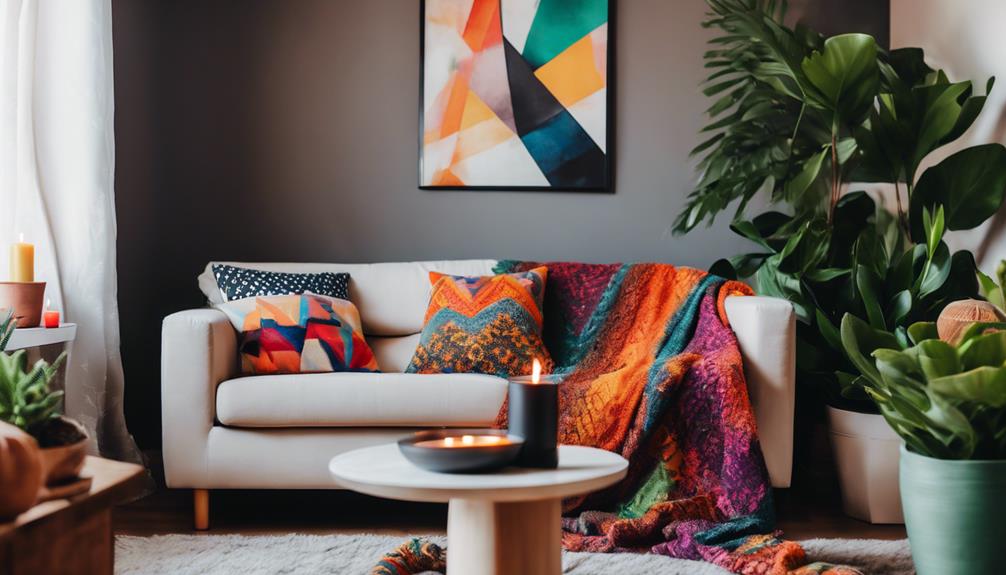
Seasonal color trends set the stage for a revitalizing update, and adding creative home accessories can elevate your decor even further.
Oversized artwork can serve as a stylish conversation starter, infusing your space with character while keeping things budget-friendly. Consider incorporating decorative accents like coffee table books featuring black and white photography to add a touch of sophistication and visual interest to your living room.
Faux leather pillow covers are perfect for enhancing the texture of your home decor. They provide a trendy contrast that's ideal for those seasonal updates. Alongside these, transforming lamp shades is an effective way to refresh your home. Opt for darker shades to elevate the style and ambiance of any room, making it feel more inviting.
Don't forget about affordable florals! You can easily source fresh arrangements from local stores, giving your space that vibrant, seasonal touch without breaking the bank.
Budget-Friendly Decor Ideas
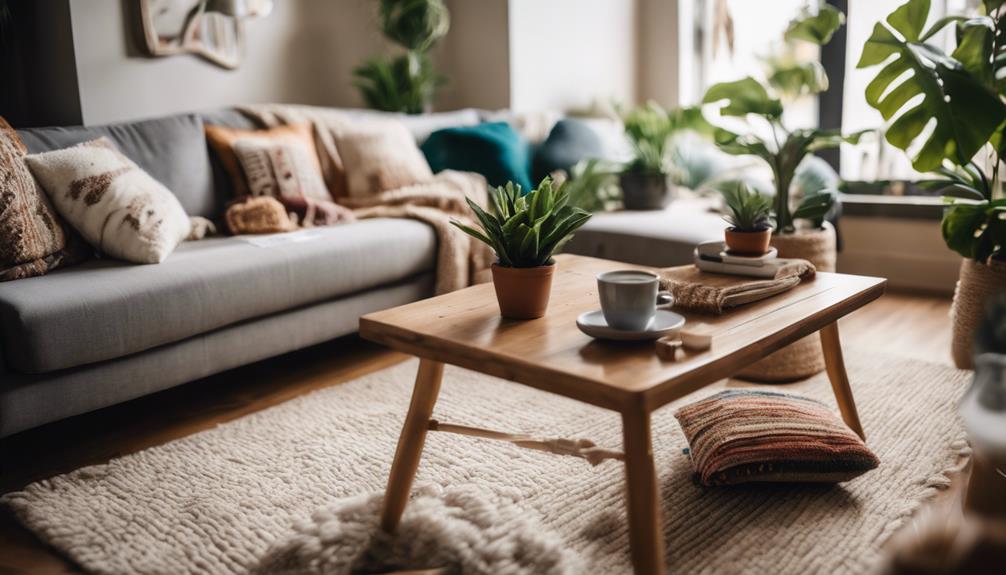
Discover how budget-friendly decor ideas can transform your space into a stylish haven without draining your wallet.
Start by exploring budget-friendly decor items that bring elegance and charm to your interiors. Keep an eye on monthly sales and clearance finds to uncover unique home accents that elevate your style at a fraction of the cost.
Consider incorporating oversized artwork or unconventional pieces as conversation starters, adding character to your rooms while staying within budget.
DIY projects are another fantastic way to personalize your space; get creative and make decor that reflects your personality without spending a fortune.
Don't overlook thrifted items, which can often be gems waiting to be discovered. They not only save you money but also contribute to a distinctive aesthetic.
To stay inspired, join online communities or follow channels dedicated to budget decorating. These platforms are treasure troves of tips and tricks to help you maximize style without overspending.
Frequently Asked Questions
What Is an August Smart Lock?
An August Smart Lock lets you control your door remotely using your smartphone. You can create unique access codes for guests and enjoy keyless entry, all while keeping your existing keys and enhancing security effortlessly.
Are Yale and August the Same Company?
Yes, Yale and August are part of the same parent company, Assa Abloy. Both brands focus on smart lock technology, enhancing home security and convenience, but they offer different features and installation options.
How Many Generations of August Smart Lock Are There?
You might think all smart locks are the same, but August Smart Lock has evolved through four generations. Each one enhances security and convenience, ensuring you stay ahead in home automation technology without compromising on ease of use.
What Is the Best Automatic Door Lock in 2024?
When choosing the best automatic door lock in 2024, consider the August Wi-Fi Smart Lock for its direct connectivity and advanced security features, or the Yale Approach™ for seamless smart home integration and ease of use.
Conclusion
To wrap it up, updating your home with stylish accessories this August doesn't have to break the bank.
For example, think about how a simple, vibrant throw pillow can transform your living room's vibe. You'll not only refresh your space but also create a cozy atmosphere for gatherings.
Embrace these must-have items and let your home reflect your personal style while staying on-trend.
Get ready to enjoy a renewed space that feels just right for the season!
Home Decor
No, Your Scandinavian Kitchen Doesn't Have to Be All White
Transform your Scandinavian kitchen with vibrant colors and textures that defy the all-white norm—discover how to make it truly yours!
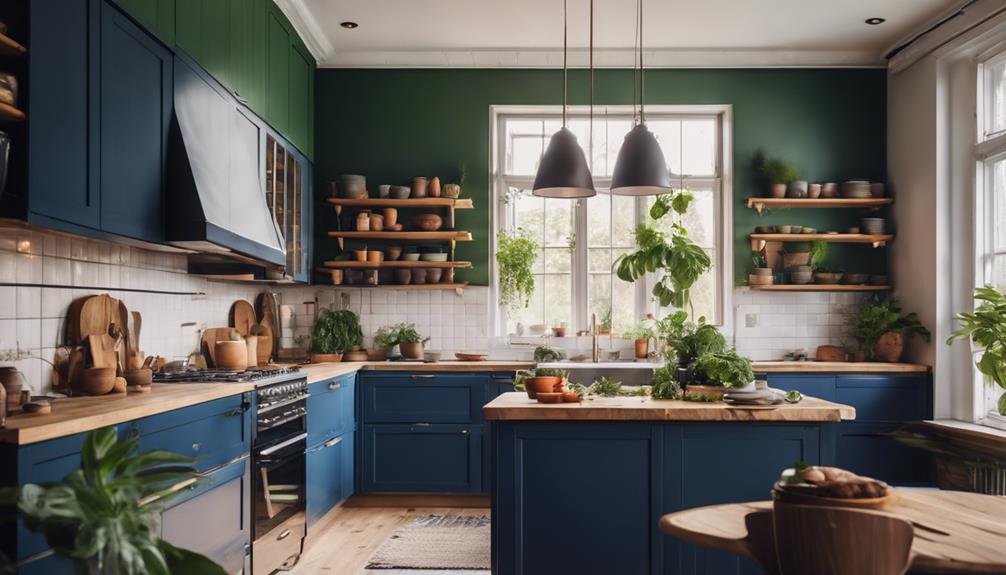
No, your Scandinavian kitchen doesn't have to be all white. You can embrace soft pastels, muted tones, and even bold accents to create a vibrant space. Think about colorful cabinetry paired with natural materials like wood and stone for warmth and texture. Light fixtures can act as eye-catching focal points while layered textiles add depth and personality. And don't forget about flooring options such as engineered hardwood or cork. It's all about mixing colors and textures to make your kitchen uniquely yours. Stick around, and you'll uncover more ideas on how to transform your space.
Key Elements
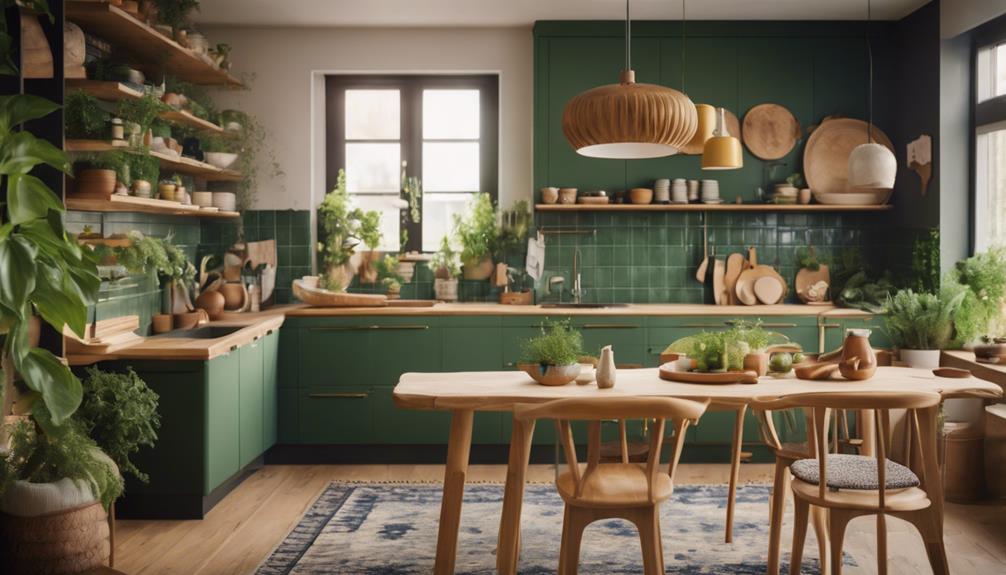
When you think about Scandinavian kitchen design, the key elements like color scheme, materials, and textures come into play.
You'll find that soft pastels and natural materials create a warm and inviting space.
Mixing textures adds depth, making your kitchen feel both functional and stylish.
Color Scheme
A vibrant color scheme in Scandinavian kitchen design goes beyond traditional whites, incorporating soft pastels, muted tones, and bold accents to infuse warmth and personality into the space. Embracing Scandi style means you don't have to settle for a sterile look; you can play with colors that reflect your taste.
Consider white walls as your canvas, allowing colorful cabinetry and accessories to pop. Soft blues, gentle greens, and warm yellows can create a welcoming atmosphere, while bold colors can serve as eye-catching focal points. This mix enhances visual interest without sacrificing the clean lines that define Scandinavian aesthetics.
Don't shy away from mixing textures and patterns either—this adds depth to your kitchen while maintaining a minimalist appeal. By strategically placing accent colors, you can create a balance between comfort and simplicity, ensuring your kitchen feels inviting yet organized.
The use of natural materials like wood and stone complements these colorful elements, reflecting your personal style while staying true to the functional ethos of Scandi design. So go ahead and experiment; your Scandinavian kitchen can truly be a vibrant expression of who you are.
Materials
Scandinavian kitchen design thrives on a mix of materials like natural wood, stone, and concrete, enhancing warmth and texture while maintaining simplicity. While white cabinetry remains popular, incorporating bleached wood accents can create a balanced aesthetic that adds depth without overwhelming the space. This combination keeps the design true to Scandinavian principles while introducing a touch of color.
Durable materials are also essential in this style. Quartz countertops and recycled components are increasingly favored, allowing you to promote sustainability without sacrificing elegance. Using stone or concrete elements can ground the design, providing a sturdy, earthy contrast to the often light and airy feel of white surfaces.
Don't shy away from integrating textured elements, like patterned tiles or metal fixtures, as they can add visual interest and break up the monotony of a mainly white palette. Accessories, furniture, and decor in vibrant colors can further infuse your kitchen with personality, moving beyond the all-white norm.
Textures
Incorporating a variety of textures, from soft textiles to sleek metals, adds depth and warmth to your Scandinavian kitchen, steering clear of a stark all-white aesthetic. Mixing materials, such as concrete tiles with wooden cabinetry, creates visual interest and aligns with contemporary Scandinavian trends. You can enhance this balance by introducing textured elements like woven baskets and ceramic dishes, which not only serve as functional decor but also contribute to the cozy, lived-in atmosphere typical of Scandinavian homes.
Layering different textures is key; imagine a plush rug underfoot paired with smooth countertops, promoting a tactile experience that invites engagement. This thoughtful approach encourages comfort and makes your kitchen feel more welcoming.
Additionally, consider using contrasting finishes, such as matte versus glossy surfaces. This interplay can highlight architectural features and prevent your kitchen from feeling monotonous.
Essential Fixtures and Furniture
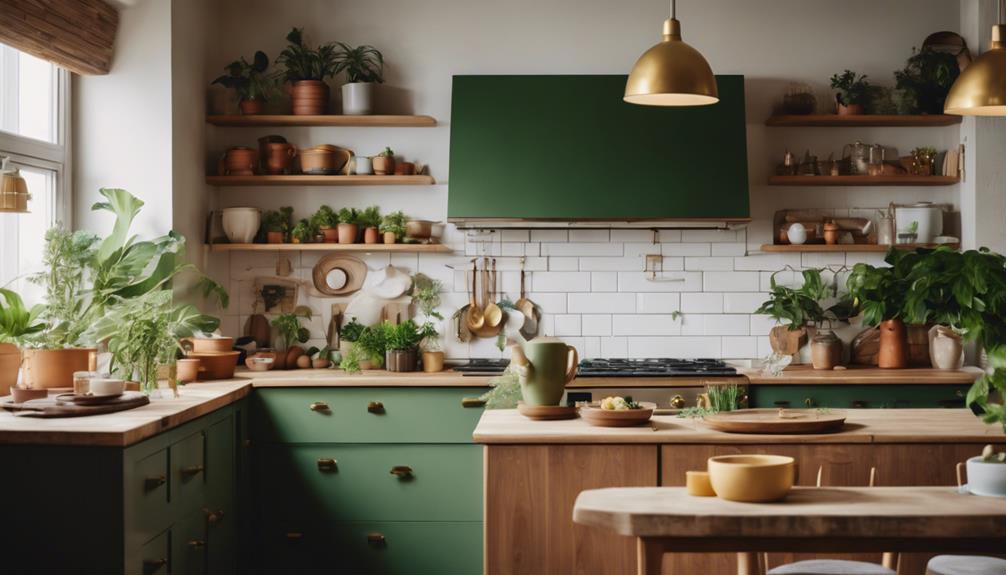
When designing your Scandinavian kitchen, choosing essential fixtures and furniture is vital for achieving that signature look.
A sleek Scandinavian sink paired with a minimalist pull-down faucet not only enhances functionality but also aligns with your aesthetic.
Don't forget to incorporate stylish pendant lighting to create an inviting atmosphere while illuminating your workspace.
Sleek Scandinavian Sink Design
A sleek sink design in your kitchen can elevate both functionality and style, embodying the essence of Scandinavian aesthetics. Scandinavian design often prioritizes clean lines and minimalistic forms, guaranteeing your sink seamlessly integrates into modern kitchen layouts. Opting for durable materials like stainless steel or composite not only enhances the sleek appearance but also assures longevity.
Consider an under-mount sink, a popular choice that creates a streamlined look and simplifies cleaning compared to traditional drop-in models. In Scandinavian kitchens, large, deep sinks are common, allowing you to handle both cooking and cleaning tasks with ease. Pairing these sinks with high-arc faucets adds further functionality while maintaining the minimalist vibe.
Don't forget about accessories! Cutting boards and colanders designed to fit over your sink can maximize workspace without compromising the clean aesthetic central to Scandinavian design. This thoughtful approach to sink selection guarantees that your kitchen remains not only stylish but also practical for daily use.
Minimalist Pull-Down Faucet
The sleek design of a minimalist pull-down faucet perfectly complements the streamlined aesthetics of Scandinavian kitchens, enhancing both functionality and style.
When you choose a faucet with a clean, modern silhouette, you're elevating the overall Scandi look while ensuring practicality in your space. These fixtures usually come in durable materials like stainless steel or matte black finishes, adding a contemporary touch that pairs well with your design scheme.
The pull-down feature is a game changer, allowing you to easily maneuver the faucet for various kitchen tasks.
Whether you're rinsing dishes or filling large pots, you'll find the increased reach incredibly convenient. Plus, many of these faucets utilize a single-handle design, promoting simplicity and ease of use, which is essential for maintaining a clutter-free countertop.
Scandinavian-Style Pendant Light
Scandinavian-style pendant lights enhance your kitchen's aesthetic with their clean lines and minimalist designs, ensuring both beauty and functionality. These essential fixtures often feature natural materials like wood and metal, reflecting the Scandi emphasis on simplicity and practicality in kitchen design.
You'll find that statement lighting—like oversized or uniquely shaped pendant lights—can act as enchanting focal points, adding character and warmth to your space. Placing pendant lights above kitchen islands or dining areas is a common practice in Scandinavian design, fostering social interaction and creating a cozy atmosphere that invites gatherings.
When selecting pendant lights, consider brands like Muuto and Gubi, which offer a range of options that blend contemporary design with traditional Nordic elements. This approach allows you to cater to diverse style preferences while maintaining the minimalist essence of Scandi design.
Lighting Ideas
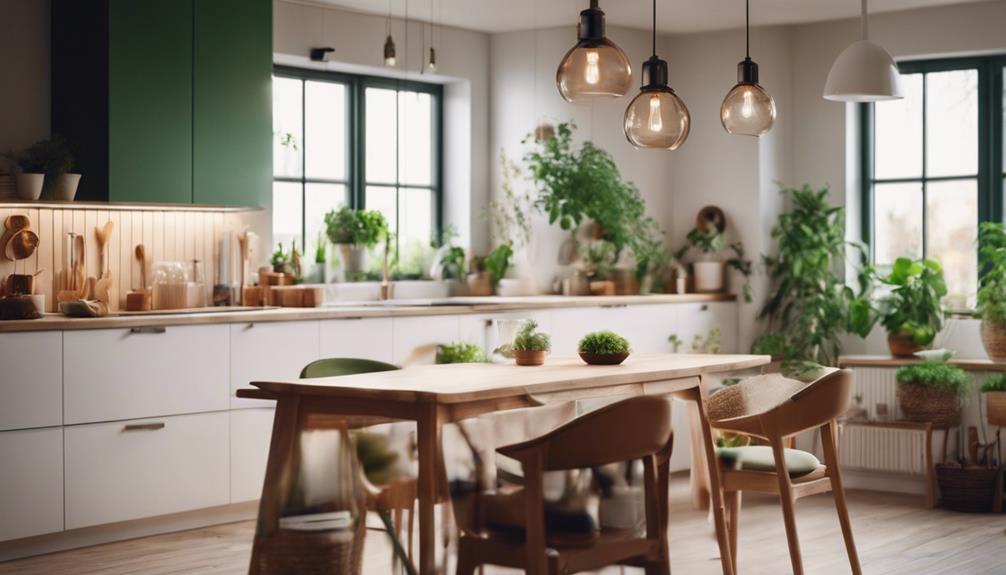
When it comes to lighting in your Scandinavian kitchen, you can transform the space with a mix of warm LED under-cabinet lights and statement pieces featuring geometric shapes.
Maximizing natural light through large windows and mirrors not only brightens the room but also enhances its airy feel.
Additionally, consider recessed ceiling spotlights for a sleek look that complements the overall design while providing functional illumination.
Warm LED Under-Cabinet Lighting
Enhancing your kitchen's ambiance with warm LED under-cabinet lighting not only creates a cozy atmosphere but also highlights the beauty of your cabinetry and countertops. This lighting solution is perfect for Scandinavian kitchens, as it adds warmth to wood and colored cabinetry while softening the starkness often found in all-white designs.
Warm LED under-cabinet lighting is energy-efficient, consuming up to 75% less energy than traditional incandescent bulbs, making it a sustainable choice for eco-conscious homeowners. You can choose from various color temperatures, typically ranging from 2700K to 3000K, to complement the soft pastels and muted tones common in Scandinavian interiors.
Not only does this lighting improve visibility for meal preparation, but it also creates depth and dimension, effectively showcasing the textures and patterns of your cabinets and countertops. By strategically placing warm LED strips or fixtures, you can foster a cozy ambiance in the evenings, encouraging social interaction and relaxation in your kitchen space.
Natural Light Maximization Techniques
Maximizing natural light in your kitchen can transform the space into a bright and inviting area, perfectly aligned with the airy essence of Scandinavian design.
Start by incorporating large windows or glass doors, which not only invite abundant natural light but also create a seamless connection with the outdoors.
To further enhance the light, use reflective surfaces like glossy cabinets or metallic accents; these bounce light around the room, amplifying brightness. Opt for light-colored walls and countertops to improve light reflection, making your kitchen feel more spacious and open.
If your kitchen lacks wall space for windows, consider installing skylights or light tubes. These features allow natural light to flood in from above, illuminating the space beautifully.
Additionally, open shelving can help avoid visual clutter and permit light to flow freely. This not only showcases the beauty of your kitchen items but also emphasizes the natural light that pours in.
Recessed Ceiling Spotlights
Recessed ceiling spotlights perfectly complement the natural light strategies you've implemented, offering a sleek and minimalist lighting solution that enhances the Scandinavian kitchen aesthetic. These fixtures not only provide ample illumination but also blend seamlessly into your ceiling, maintaining the clean lines characteristic of Scandinavian design.
By strategically placing recessed ceiling spotlights, you can highlight key areas like countertops and dining spaces. This approach enhances both functionality and visual appeal, ensuring your kitchen feels both inviting and efficient. Plus, many of these lights are dimmable, allowing you to adjust the brightness for various moods and activities, making your kitchen versatile for cooking, entertaining, or relaxing.
If you're committed to sustainable living, consider using energy-efficient LED bulbs in your recessed ceiling spotlights. This choice not only reduces energy consumption but aligns perfectly with the eco-friendly practices often embraced in Scandinavian design.
Ultimately, recessed ceiling spotlights are an ideal lighting solution, enhancing your kitchen's simplicity and functionality while keeping it clutter-free. So, embrace this stylish option and elevate your Scandinavian kitchen to new heights.
Statement Lighting With Geometric Shapes
Statement lighting featuring geometric shapes transforms your Scandinavian kitchen into a modern aesthetic, adding both style and character. These unique fixtures, like pendant lights and chandeliers, act as stunning focal points, drawing attention and creating visual interest above your kitchen island or dining area.
Using materials such as metal, glass, or wood in your geometric lighting enhances the natural and functional appeal of Scandinavian decor, fostering a warm and inviting atmosphere. You can break the monotony of a chiefly white kitchen by incorporating bold colors or unique shapes in your statement lighting. This approach introduces personality and character without overwhelming the simplicity of the space.
Moreover, geometric lighting goes beyond mere functionality; it allows for creative expression that aligns with contemporary trends. By blending traditional Scandinavian simplicity with modern flair, you'll achieve a striking balance.
Whether you choose minimalist designs or more intricate shapes, statement lighting can elevate your kitchen's overall design, making it feel fresh and contemporary. Embrace these geometric lighting ideas, and watch your kitchen come alive with vibrant energy and style.
Decorative Elements

Incorporating decorative elements like a handwoven textile wall hanging or a ceramic vase filled with dried flowers can add personality to your Scandinavian kitchen.
A wooden bowl with natural accents not only serves a functional purpose but also enhances the warm, inviting feel of the space.
These touches create a balance between minimalism and individual expression, making your kitchen truly yours.
Handwoven Textile Wall Hanging
Handwoven textile wall hangings bring warmth and texture to Scandinavian kitchens, enhancing the minimalist design with their vibrant colors and unique patterns. These decorative elements often feature natural fibers like wool and cotton, aligning perfectly with the Scandinavian focus on sustainable materials.
By incorporating handwoven textile wall hangings, you can create striking focal points that break the monotony of the typical white and neutral tones. The bold colors and geometric designs of these textiles allow you to express your individual style while maintaining the cozy atmosphere that Scandinavian interiors are known for.
Whether you choose a large statement piece or a series of smaller hangings, each one adds character and depth to your kitchen. Moreover, the artisanal craftsmanship behind handwoven textile wall hangings often reflects local traditions, infusing your space with a sense of cultural heritage and authenticity.
This makes them not just decor but also a story of community and creativity. So, don't shy away from adding these eye-catching elements; they can transform your kitchen into a warm, inviting space that feels uniquely yours.
Ceramic Vase With Dried Flowers
How can a ceramic vase filled with dried flowers enhance the warmth and personality of your Scandinavian kitchen? This simple addition can break the monotony of an all-white aesthetic, bringing life and character into your space.
Dried flowers aren't only visually appealing but also low-maintenance, making them perfect for busy kitchens. They provide texture and interest, complementing the minimalist design typical of Scandinavian decor.
Choosing a ceramic vase in various shapes and colors allows you to express your style without overwhelming the kitchen. You'll find that these vases can evoke a sense of nature and hygge, essential elements that promote comfort and coziness.
Additionally, if you opt for locally sourced or artisanal ceramic vases, you'll be supporting sustainable practices that align with the eco-friendly values often found in Scandinavian design.
Wooden Bowl With Natural Accents
A wooden bowl filled with natural accents not only brings warmth to your Scandinavian kitchen but also enhances the space's minimalist charm. These bowls serve as both functional and decorative elements, making them perfect for food prep or serving. Imagine the kitchen sounds of fresh fruits being tossed into a beautifully crafted bowl, elevating your everyday tasks.
Incorporating sustainably sourced wood aligns with eco-friendly practices and adds a rustic touch that complements the overall design ethos. You can place a wooden bowl on your countertop or dining table, where it becomes a focal point, breaking up the monochromatic palette typical in Scandinavian design.
Pair your wooden bowl with other natural materials like stone or ceramic to create a layered texture that invites warmth and coziness into your kitchen. This thoughtful integration of decorative elements reflects the values of simplicity and functionality inherent in Scandinavian interiors.
Flooring
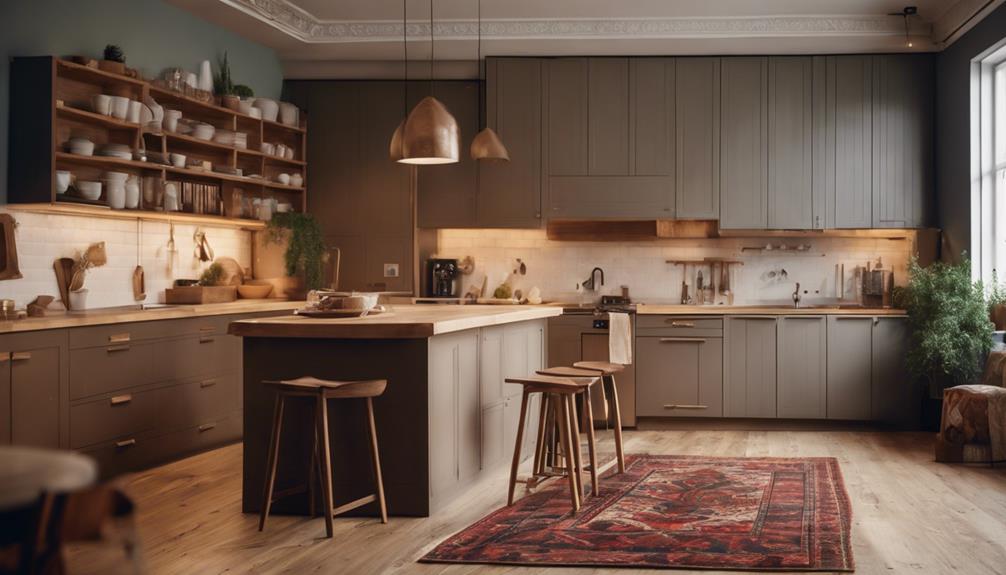
When choosing flooring for your Scandinavian kitchen, consider engineered hardwood with a light finish for a bright, warm feel.
If you want added comfort, cork flooring can bring warmth underfoot while maintaining a sleek look.
For a more modern touch, polished concrete offers durability and a clean aesthetic that fits perfectly in a minimalist design.
Engineered Hardwood With Light Finish
Engineered hardwood with a light finish creates an airy atmosphere in your kitchen, perfectly aligning with the essence of Scandinavian design. This flooring option enhances the spacious feel typical of Scandinavian interiors, making your kitchen bright and inviting.
Engineered hardwood floors combine a core of plywood or high-density fiberboard with a top layer of real wood, giving you the beauty of solid wood while ensuring durability and moisture resistance. You'll appreciate that light-finished engineered hardwood is less prone to showing scratches, dents, and wear, making it a practical choice for high-traffic areas like your kitchen.
With various wood species available, such as oak and maple, you can easily complement any color palette—from soft pastels to vibrant accents—within your Scandinavian design.
Installation is versatile, too; whether you prefer a floating, glue-down, or nail-down method, engineered hardwood fits into different kitchen layouts and preferences seamlessly.
Cork Flooring for Warmth
Cork flooring offers a warm, inviting touch to your Scandinavian kitchen, perfect for those chilly months. This eco-friendly option provides natural insulation, helping to keep your space cozy when temperatures drop. The unique cellular structure of cork flooring not only traps warmth but also absorbs sound, creating a quieter environment—ideal for family gatherings or cooking adventures.
Durability is another standout feature of cork flooring. It can withstand heavy foot traffic, making it resilient enough for your bustling kitchen. Plus, you'll appreciate the variety of colors and patterns available, allowing you to personalize your design while complementing the vibrant accents typically found in Scandinavian interiors.
Being a natural material, cork flooring is hypoallergenic and resistant to mold, which enhances your kitchen's indoor air quality. This means you can enjoy a healthier cooking and dining experience without compromising on style.
Polished Concrete for Durability
Polished concrete flooring stands out for its exceptional durability, making it an ideal choice for the high-traffic areas of your Scandinavian kitchen. This flooring option resists scratches and stains, ensuring it can withstand the hustle and bustle of everyday life without losing its appeal.
Plus, its ability to reflect light enhances the brightness of your space, seamlessly complementing the minimalist aesthetic that defines Scandinavian design.
You'll appreciate the low-maintenance aspect of polished concrete, as it requires only occasional cleaning and sealing to keep it looking fresh. With various finishes and colors available, you can easily customize your flooring to align with your vibrant or muted color schemes.
Additionally, polished concrete has thermal mass properties, which means it can help regulate indoor temperatures, contributing to energy efficiency in your home. This not only keeps your kitchen comfortable but also can lead to savings on energy bills.
If you're looking for a flooring option that combines style, durability, and practicality, polished concrete is definitely worth considering for your Scandinavian kitchen.
Conclusion
You don't have to stick to an all-white palette for your Scandinavian kitchen.
Embrace color and personality by incorporating vibrant fixtures, bold decorative elements, and unique flooring choices.
By mixing essential furniture with eye-catching accents, you'll create a warm and inviting space that reflects your style.
Remember, the heart of your kitchen should be a reflection of you, so let your creativity shine and enjoy the process of making the space truly yours!
-

 Vetted2 months ago
Vetted2 months ago14 Best Personalized Father's Day Gifts for Your Husband – Show Him You Care
-

 Alfresco1 month ago
Alfresco1 month agoAlfresco Stacker Doors: Seamless Indoor-Outdoor Living!
-

 Craft and Textiles3 months ago
Craft and Textiles3 months ago15 Best Places to Buy Appliances for Your Home – Top Retailers Reviewed
-

 Decorative Throws3 months ago
Decorative Throws3 months agoIs It Better to Dry Clean Blankets?
-

 Tableware and Dining Accessories3 months ago
Tableware and Dining Accessories3 months agoWhat Is the Meaning of the Word Tableware
-

 Tableware and Dining Accessories3 months ago
Tableware and Dining Accessories3 months agoWhat Is the Hindi Meaning of Tableware
-

 Craft and Textiles3 months ago
Craft and Textiles3 months ago15 Best Cordless Mowers for Effortless Lawn Care – Top Picks of 2024
-

 Yarn3 months ago
Yarn3 months agoIs Yarn Natural or Manmade? Unravel the Truth























